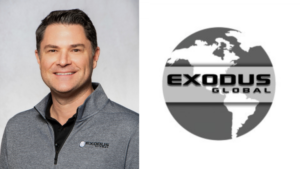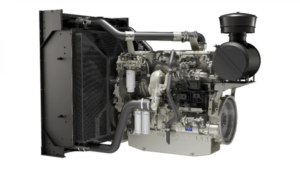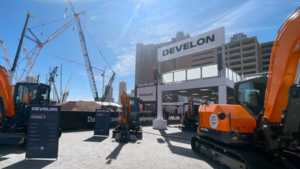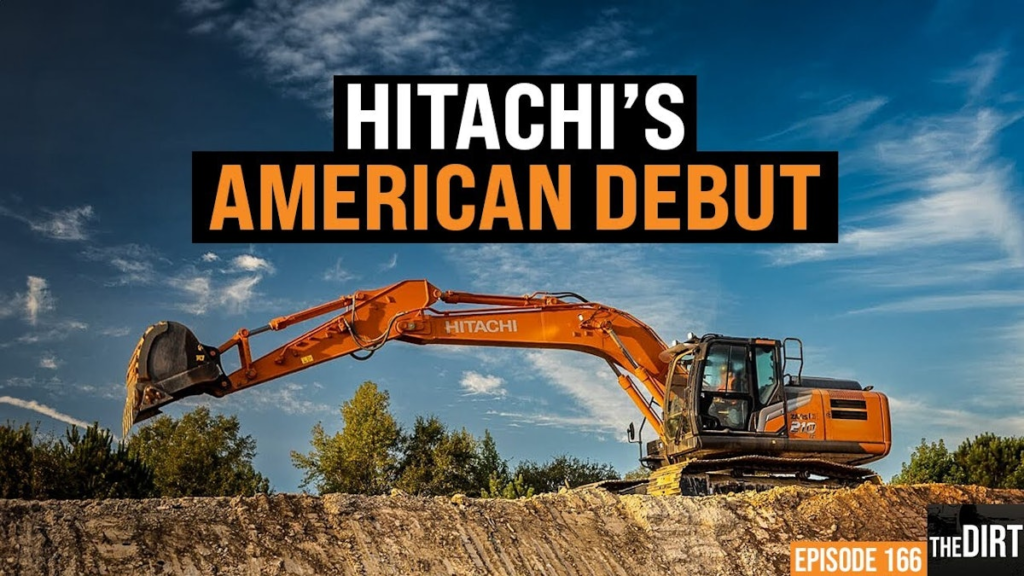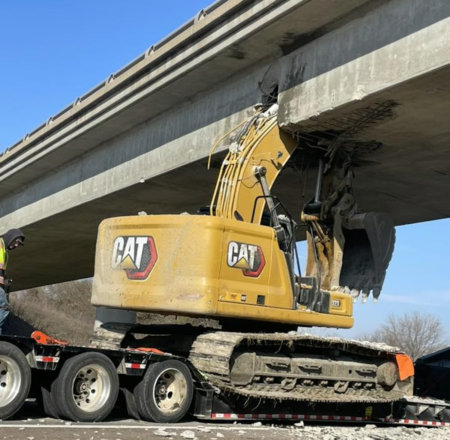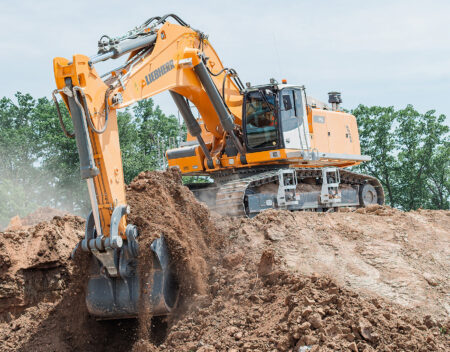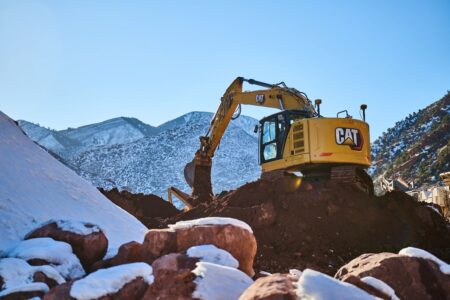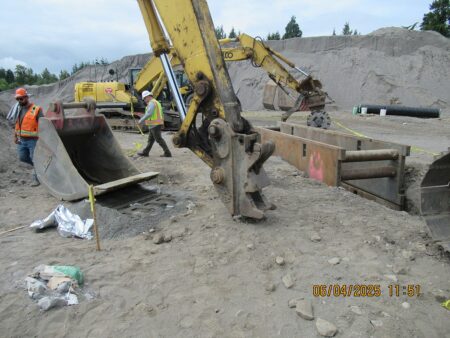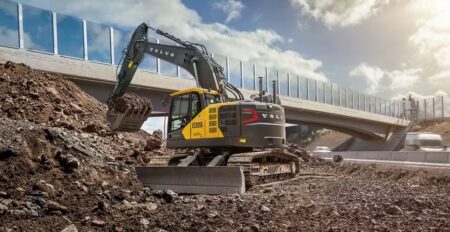Bryan Furnace (00:00):
Welcome back to Equipment World. You’re watching The Dirt. I’m your host Bryan, and today we’re here to talk to Hitachi. We are now a good ways out from the split with John Deere, and I’m kind of curious, what does the landscape look like for Hitachi now that they’re flying solo? So without further ado, here’s Patrick from Hitachi to give us a lay of the land. So my big question for you, which I’m sure a lot of people in the industry have, is what does the landscape look like for Hitachi kind of post John Deere split? How has that impacted production and product development? What does the world look like now for you guys?
Patrick Baker (00:48):
Yeah. So the world is constantly changing on the Hitachi side, especially since the dissolution of the joint venture with John Deere. To give you a little bit of a preface, back in the late ’80s, John Deere and Hitachi linked up, created a joint venture where Deere would be selling both Hitachi and John Deere excavators while Hitachi would be handling all of the manufacturing. And that relationship lasted until March 1st of 2022, where Hitachi Construction Machinery based in Japan, decided that that joint venture would end and Hitachi would create HCMA, Hitachi Americas. That includes South America, Central America, as well as North America. And for the last 20, 21 months, we’ve introduced almost 20 new products. We’ve built a multimillion dollar customer experience headquarters in Newnan in Georgia, just south of Atlanta, to really show the investment to the Americas, to our dealers, to our customers that we’re here for the long term and we’re here to really build a strong OEM business here in the Americas with the Hitachi brand.
(01:56):
But like you mentioned, Bryan, everything is in flux. Everything has changed just in the last 20, 21 months. New people, new systems, new products, it’s all new. We’ve done some things really, really well. We make a really, really good excavator product and wheel loader product, but we’re certainly learning from some shortfalls in setting up dealer network. We’re learning how to implement and improve processes on the go as we create them on the back end to handle invoicing, shipping, you name it, it’s all being created from scratch. But what we really hang our hat on is the product and being easy to do business with and really creating the best customer experience and dealer experience we can for new and old Hitachi dealers and customers.
Bryan (02:42):
Awesome. So now that you’re kind of in the new world here, post Deere split, can you tell us about the new Dash 7 model excavators and kind of what differentiates them from the predecessors?
Patrick (02:55):
Absolutely. So March 1st, 2022 was again the introduction of HCMA to North America. We brought on a number of new dealers and we brought out a whole new line of construction size excavators. We had some new compact excavators as well as new wheel loaders. Within that span from March 1st, 2022 to about March 1st, 2023 CONEXPO timing, we launched 13 new Dash 7 construction size excavators. So that’s 13 ton all the way to 90 ton. Those models went from Dash 6 to Dash 7 generation on the compact side, we had the ZX 75 and ZX 85 go from a Dash 5 to a Dash 7. And we also have seen four wheel loaders, the 160, the 180, the 220, and our 310 all jump in generation to that Dash 7. So what that means in just a Dash 7 overview for both excavators and wheel loaders is a focus on productivity, performance, reliability, durability and technology. You’re going to find, for example, in all the Dash 7 equipment, an eight-inch LCD anti-glare display in the cab, a dual adjustable seat and console where the joysticks and your operation levers are going to travel with the operator in the seat.
Bryan (04:17):
Love that setup.
Patrick (04:18):
To being able to find that really comfortable operating setup to keep the operator productive. The way I like to look at the cab is that’s someone’s office. That’s someone’s cubicle-
Bryan (04:28):
Absolutely.
Patrick (04:29):
… 8, 10, 12 hours a day, you want that person as comfortable as possible to really keep their foot down on the throttle, so to speak, and really keep moving dirt load and pipe, whatever they’re doing, we want them productive. One of the things that Hitachi is known for, and they’ve been known for decades now, is our hydraulic system, specifically on our 210 excavator to our 350 excavator. We have a very unique hydraulic system in the TRIAS III system, and that’s three pump hydraulic system compared to a more conventional two pump system. This allows us to be very, very fuel conscious and prove breakout force and prove lift capacity. And there’s a lot of additional customization features that Hitachi has been able to implement with that third pump included in that hydraulic system.
(05:17):
For example, if you’re on top of a bench and you’re loading trucks, that third pump is dedicated to your swing in your track. So if you’re not tracking or doing a lot of swinging, you can actually prioritize that third pump to give you added breakout, added performance and productivity on that front end on your boom bucket and arm cylinders. Getting a lot of recirculation of that hydraulic fluid, faster cycle times, higher fuel efficiency. It’s effortless with that third pump kicking in to generate more power and more productivity. Larger cab on all the Dash 7s, that’s both length and head space. I actually find I’m a very average male, 5’10, 200 pounds, but I even notice the added head space really makes the cab feel roomy, comfortable, great visibility. We do offer the aerial angle 270 degree camera system.
(06:16):
So standard on all of our excavators from the 75 all the way to our 890, we have the aerial angle system, so it’s a left rear and right side camera paired with an LED light. So you have full visibility with six different view screens on your end cab display, really prioritizing that job site safety. Knowing the environment, knowing who you’re working around, knowing the machines you’re working around, and really putting an emphasis on the visibility, not only what you’re looking at in front, but everything going on around the machine. I didn’t mention anything about our power system. We use Isuzu engines on our construction machines. We do have, for our 16 and 19 ton, we use a Yanmar engine. We went to that because we went from 110 horsepower up to 132 horsepower, adding some performance and productivity benefits as well as availability from Yanmar to be able to get those engines into our excavators more quickly. But with the Isuzus, we don’t run a diesel particulate filter on the after treatment. That’s a really nice feature.
Bryan (07:21):
So I want to go back to your tri pump system. If I understand it correctly, as long as you’re not using one of the functions that that pump is dedicated to through the computer, you can actually go in and kind of tell it what you want to prioritize as an operator. Did I understand that correctly?
Patrick (07:38):
Yeah, exactly. So if you’re just focused on loading trucks as quickly as possible, we can take that third pump, through the end cab display and just using the jog dial increase and decrease where that flow is going to be generated. On the flip side, say you’re running a mulching head and you need to slowly track along the side of a road or you’re doing some sort of road or highway construction where tracking or even pipeline where you’re having to carry pipe, you can again engage that third pump to increase your track capability, your swing speed. And again, that’s just going to give the operator the ability to customize to their application to not only have better performance and productivity, but really see your fuel consumption and your fuel efficiency really, really increase. There’s no wasted energy in a Hitachi excavator.
Bryan (08:36):
So is that pump system on all units? Is it only a certain section of your product line? Where would you find the tri pump system?
Patrick (10:32):
Yeah. So that’s a great question and what we’ve done, so from our 13 ton to our 19 ton, so that’s the ZX130 to the new ZX190, which we launched at CONEXPO as well. That’s a two pump system, conventional system, very similar to what you see amongst our competitors. The reason for only two pumps in those size models is due to the size of the upper structure. The size was not sufficient enough to add that third pump. Now, as you get into the 20 ton at the 210 level all the way to our 35 ton, the ZX350, the bread and butter three pump system really, really makes those machines special on the production and performance side with the customization of that third pump. As you get into the larger excavators, the 490, 690 and 890 up to our 90 ton, we go back to that two pump more conventional hydraulic setup. And obviously as the larger we get, the upper structure is getting larger, so it’s not a space issue. But for those larger excavators, they’re working in aggregate quarry mass excavation, they’re not so much the tool carrier needing to be quite as versatile on the hydraulic side as those 20 to 35 ton units, those excavators. So the most production and performance out of those three large machines is with that standard two pump setup.
Bryan (12:00):
Interesting. I do love that as we continue to progress with technology in our industry, you’re getting more and more granular at how you can customize these machines to do a task. It’s no longer just this brute force tool that you go out and it kind of does everything. It’s literally you can start dialing in specifics to your application on that day, what you’re doing. I love the fact that we’re starting to get that granular with this stuff. That’s really awesome.
Patrick (12:28):
Yeah, I couldn’t agree more. 20, 25 years ago, an excavator was just holding pipe, putting in conduit, helping dig a trench for utilities. But the investment needed to purchase an excavator today, it has to do more. It has to support more attachments. You have to be able to reach and complete more jobs as a customer. So it makes sense, this evolution of excavators not just being mass excavation earth moving machines, they’re doing everything today. And the attachments continue to grow, the customization continues to grow, and it’s something that Hitachi is very, very focused on as we continue to get feedback from our dealers and our customers about products and kits and options that they want to see for the future.
Bryan (13:17):
Yeah, excellent. So I’m going to shift gears on you. What has caused Hitachi to kind of take a non-traditional route of not establishing a dealer network like a lot of the other OEMs?
Patrick (13:30):
Yeah. So this is a great question, and I’ve spoke at length with our senior leadership here at HCMA and as well as many of my colleagues back in Japan at the parent company HCM. When HCMA came on board March 1st, 2022, there was an enormous appetite to bring in and bring on Hitachi products, excavators, wheel loaders, and the process of bringing those dealers on was very, very stringent. We wanted the dealership, the dealer culture, the people at the dealership to match the culture we envisioned, and we wanted to be able to envision their culture with Hitachi equipment. And we were very selective about picking dealers regionally that had other product lines because HCMA offers wheel loaders and excavators. We don’t have a skid steer, we don’t have a compact track loader, we don’t have a backhoe at this time. Long-term strategy 5, 10, 15 years down the line, over time we may become that OEM, but we needed to pair with dealers that had some of the equipment that we were not manufacturing or producing.
(14:44):
So a customer looking for a ZX35, a three and a half ton compact could find the CTL, could find the stand-on track loader, this skid steer that they needed for their landscape business or their utility company. Because we knew we couldn’t have a customer dropping off the excavator at the Hitachi dealer in the CTL at the Bobcat dealer. We needed everything to be at one location, sharing the same core values, the same culture, and the same long-term growth strategies as Hitachi America’s. And that’s been a challenging process. We could have had dealers in every state and every region and every corner of North America, March 1st 2022 if we wanted. But again, we’ve been very precise about the relationships we’re getting into that we’re building with our dealers. The dealers had to understand where we were. Everything was starting from scratch. They had to understand that it was going to take patience and time for us to ramp up, to bring in volume, to set up systems and processes.
(15:47):
So it’s very much a give and take. It was not just sign on the bottom line, here’s your Hitachi products. It’s very much a collaborative effort, and that’s why it’s been so amazing to see the growth in the last almost two years with the dealers we’ve brought on board, the dealers that were previous Hitachi wheel loader dealers that now brought on the excavator line. The amount of training we’re putting out, the amount of customer surveys and traveling we’re doing to get in front of our dealers and customers to understand the North American market and maybe where we’re excelling and maybe where we’re missing some options, some items, some configurations. So it’s this intertwined rubber band ball that just continues to grow layer by layer as we get better and grow momentum and add those key dealers in those key areas.
Bryan (16:38):
Gotcha. So I’ve got one for you. As we were both just talking about, the industry’s changing, man, I feel like it’s just accelerating every day with more and more technological advances kind of impacting our industry. How does Hitachi kind of stay nimble and innovate and kind of stay ahead of that curve?
Patrick (16:58):
Yeah. And this is something that’s on the forefront for us at HCMA. But one of the key examples, and this comes directly from our product management team, is my colleague Matt Kester, he came in as a wheel loader product manager, and within eight months, we recognized that we needed someone in the technology space. So he has a master’s degree in technology, technology science. I don’t know his exact degree, but he quickly transitioned from wheel loader product manager to technology manager. So he’s working on everything from MGMC kits, to plug and play options, object detection, autonomy, electrification. Those are all projects that he’s currently working on and that are under development here at Hitachi. But I think if you watch the Hitachi brand on both wheel loaders and excavators over the next two years leading up to 2026 CONEXPO, you’re going to see some remarkable, remarkable stuff come out on the tech side for HCMA and Hitachi globally.
Bryan (18:05):
I will say, you mentioned you guys aren’t kind of a full product spectrum brand, and a lot of people might look at that as a disadvantage. I’ve always kind of considered that actually to be a pretty significant advantage because now instead of splitting your time amongst 6 to 8 to 10 product lines, you’re really able to focus on two or three and apply all of your manpower, all of your efforts in that area. And so all that to say, I am excited to see what you guys come out with because I feel like you’re able to focus that attention and really drive hard in that direction.
Patrick (18:38):
Yeah. Bryan, I love that you bring that up because if you were to come here to our Newnan and office, every department you visit, you’ll see written on a whiteboard, you’ll hear someone say it, I hear it all the time. Our number one priority right now is getting really good at the basics. We want to build a foundation that we can stand on and really build long-term success, not just for Hitachi the OEM, but for dealers and customers out there working every day trying to make a living with the Hitachi product. We could have joined ventured with a lot of other OEMs, we could have tried to bring on a skid steer and a track loader, but it would’ve been really ugly really quickly with new people and processes and systems. But senior management and our senior leadership decided that we make a really good excavator and a really good wheel loader. Let’s get those out. Let’s build brand awareness. Let’s build the dealer network. And then let’s look at a long-term strategy of becoming a full-line OEM and bringing in those other products that really complement already what we do really, really well.
Bryan (19:46):
Well, Patrick, I really appreciate the time and all the information. This has been great.
Patrick (19:51):
Yeah. Bryan, thank you so much again for the opportunity. Would love to have you down here in Newnan. We’ll have to bring you down for some demo, get you into the seed. I know you enjoyed operating the 210 Dash 6-
Bryan (20:02):
100%.
Patrick (20:05):
We’ll have to get you into a Dash 7 and do a review on that one in the coming months. But again, thank you so much for the opportunity and just the time to get to talk a little bit about Hitachi and where we’re headed and what we’ve got going on.
Bryan (20:18):
Well, thank you again for Patrick taking the time to come on the show and just give us an idea of where Hitachi’s going and what they have coming down the pipeline. As always, I hope this helps you and your business. We’ll catch you on the next episode of The Dirt.
Read the full article here

